The macro-environment is composed of forces that are external to the firm. Although the degree of impact varies, these forces affect all industries and the firms competing in them.
An external environment of an organization includes forces that it can readily affect as well as forces that largely lay beyond its influence. The latter set of forces are said to exist within the macro-environment. Because this environment often has a substantial influence on an organization’s level of success, firms must track trends and events as they evolve and anticipate their implications.
The challenge to each firm is to scan, forecast, and assess the elements in each force to predict their effects on it. Effective scanning, forecasting, and assessing are vital to the firm’s efforts to recognize trends and events, classify them as strategic factors, and then evaluate them as opportunities and threats.
PESTEL analysis is one important tool that firms can rely on to organize forces within the macro-environment and to identify how these forces influence industries and the firms within them.
PESTEL is an anagram, meaning it is a word created by using parts of other words. In particular, PESTEL reflects the names of the six forces of the macro-environment: (1) political, (2) economic, (3) social, (4) technological, (5) environmental, and (6) legal.
Firms carefully examine each of these six segments to identify major opportunities and threats and adjust their firms’ strategies accordingly.
Force 1: Environmental Force
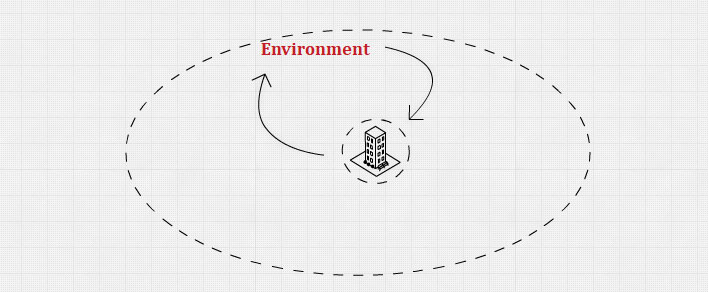
Environmental force refers to potential and actual trends and events in the physical conditions of the natural environment within which organizations operate.
The natural environment is the ultimate source of many inputs such as raw materials, energy which business firms use in their productive activity. In fact, the availability of natural resources in a region or country is a basic factor in determining business activity in it.
There are many parts or attributes of the environmental force that firms consider as they try to identify trends and events in the natural environment.
Concerned with trends oriented to sustaining the world’s natural environment, firms recognize that ecological, social, and economic systems interactively influence what happens in this particular environment force and that they are part of an interconnected global natural society.
Companies across the globe are concerned about the physical environment, with actions taken to main corporate social responsibility and nature sustainability.
Until recently businesses had generally overlooked the serious ecological effects of their activities. Driven purely by the motive of maximizing profits, firms cause irreplaceable damage to exhaustible natural resources, especially minerals and forests. By creating external detrimental diseconomies, they imposed heavy costs on society.
Ecology refers to the relationship between humans and nature and among elements of nature themselves. Human beings, air soil, landforms, flora and fauna, rivers, oceans, and mountains must exist together in harmony. But the harmony is disrupted by industrial establishments. The effluents they discharge, the noise they generate, the smoke they eject, and their massive utilization of resources cause disruption of ecology. Firms need to take ecological trends and events into considerations while formulating strategies.
In a comprehensive sense, an increasing number of companies are interested in sustainable development, which is the development that meets the needs of the present without compromising the ability of future generations to meet their own needs.
Laws and regulations have been passed for the conservation of natural resources and the prevention of environmental pollution. These laws have imposed additional responsibilities and costs for business firms.
With a focus on the future, the analysis of the macro-environment and specifically environment force allows firms to identify its opportunities and threats.
Identifying anticipated changes and trends among forces and their elements is a key objective of analyzing this natural environment.
Due to the importance to determine the firm’s opportunities and threats, and its strategies, it is necessary to have a top management team with the experience, knowledge, and sensitivity required to effectively analyze the conditions in a firm’s natural environment and in general, its macro-environment.
Environmental force includes geographical and ecological factors such as natural disasters, pollution levels, weather and climatic patterns, water and forest resources, minerals and oil reserves, or port facilities.
The availability of minerals such as iron, coal, etc. in a region influence the location of certain industries in that region. Certain weather and climatic conditions also affect the location of certain business units. Weather and climatic conditions influence the demand pattern for clothing, building materials for housing.
Force 2: Social Force
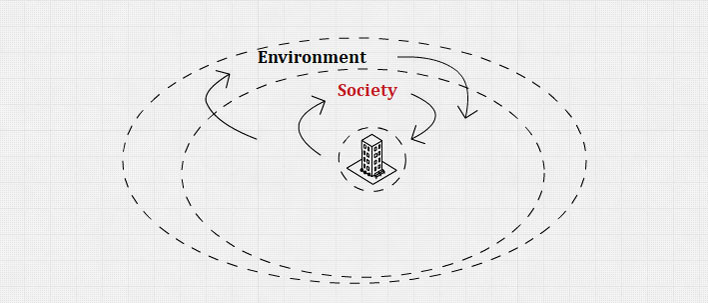
Social force refers to the way in which changing social values affect an industry. It is concerned with a society’s attitudes and cultural values.
It consists of a value system and accordingly the society’s traditions, attitudes, beliefs, desires, expectations, aspirations, habits, trends, and customs that generate opportunities and threats to firms.
These are developed from cultural, ecological, demographic, religious, education, and ethnic conditions.
Social force involves the shared beliefs and attitudes of the population. People learn to behave in particular ways as a result of the feedback from the rest of society. Behavior and attitudes that are regarded as inappropriate are quickly modified, and also people develop expectations about how other people should behave.
Changes that take place in society are caused by changes in the value system that is accepted as right for the members of the society. Thus, what a particular age group is to wear, eat, entertain is decided by cultural values.
Because attitudes and values form the cornerstone of society, they often drive demographic, economic, political/legal, and technological conditions and changes. They essentially create opportunities and threats.
Social trends are shaping the way people live, work, produce and consume. The change in the social environment creates a different type of consumers and consequently the need for different products and different services.
Members of a society wield important influence over business firms. People these days do not accept the activities of business firms without question. Activities of business firms may harm the physical environment and impose heavy social costs.
Businesses should consider the social implications of their decisions. This means that companies must seriously consider the impact of their actions on society. When a business firm in its decision-making takes care of social interests, it is said to be socially responsible.
Social responsibility is the felt obligation or self-enforced duty of business firms to serve or protect social interests. By doing so they promote social well-being. Good corporate governance should be judged not only by the productivity and profits earned by a business firm but also by its social welfare promoting activities.
Social responsibility is related to ethics. The discipline of ethics deals with what is good and bad, or right and wrong, or moral duty and obligation.
Individual societies’ attitudes and cultural orientations are anything but stable, meaning that firms must carefully scan, forecast, and assess them to recognize and study associated opportunities and threats. Successful firms must also have an awareness of changes taking place in the societies and their associated cultures in which they are competing.
There is an increasing trend for companies to expand their operations and reach beyond the boundaries of their home country.
Globalization of business provides opportunities to access larger potential markets and factors of production. At the company level, globalization means two things. First, the company commits itself heavily to several manufacturing locations around the world and offers products in several diversified industries. Second, the ability to compete in the domestic market with foreign competitors. However, globalization of business involves many risks like political, social, and economic.
The concept of a global village has changed how individuals and organizations relate to each other. The global environment represents the process of liberalization. This has resulted in the easy entry of foreign business organizations which further resulted in stiff competition and efficiency. Ultimately, liberalization has helped us in achieving a high growth rate, easy availability of goods at competitive rates, a healthy and flourishing stock market, high foreign exchange reserve, low inflation rate, strong rupee, good industrial relations, etc.
Some of the important factors and influences operating in the social environment are (1) consumption habits, (2) languages, (3) beliefs and value systems, (4) customs and tradition, (5) tastes and preferences, (6) educational levels, and (7) social concerns.
Force 3: Political Force
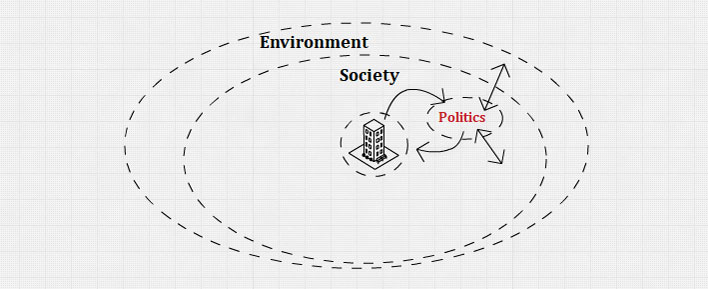
The political environment consists of factors related to the management of public affairs, general stability, government attitudes, and their impact on the business of an organization.
The political environment has a close relationship with the economic system and economic policies.
The political philosophy of the government wields a great influence over business policies. Organizations are conscious of the political environment as the influence of the political environment on their business is enormous. Most governmental decisions related to firms are based on political considerations in line with the political philosophy of the government.
This environment is the arena in which organizations and interest groups compete for attention, resources, and a voice in overseeing the body of laws and regulations guiding interactions among nations as well as between firms and various local governmental agencies.
Essentially, the environment is concerned with how organizations try to influence governments and how they try to understand the current and anticipated influences of those governments on their competitive actions and responses.
The direction and stability of political factors are major considerations for understanding the macro-environment and formulating strategies. Political factors define the legal and regulatory parameters in which an organization operates.
Government guides and controls the business through its regulations and policies. Thus the type of government running a country is a powerful influence on any business. A firm must consider the changes in the regulatory framework and their impact on the business.
The political system prevailing in a country decides, promotes, fosters, encourages, shelters, directs, and controls the business activities of that country. A stable, honest, efficient, and dynamic political system ensures the political participation of people and assures personal security to the citizens. It is a primary factor for economic development. The political system comprises three vital institutions: legislative, executive or government, and judiciary.
Fair-trade decisions, antitrust laws, tax policies, minimum wage legislation, pollution control policies, pricing policies, and many other actions are placed in front of firms with the aim of protecting consumers, employees, the general public, and the environment.
These factors reduce the potential profits of firms.
However, some political actions (subsidy, patent laws, and product research grants) are designed to benefit and protect companies. So, the political system either may limit or benefit the firms.
Some of the important factors and influences operating in the political environment are as follows: (1) the general state of political development; (2) the degree of politicization of business and economic issues; (3) the level of political morality; (4) the constitutional framework, directive principles; (5) political stability, ideology and practices of the ruling party;(6) policies related to licensing monopolies, foreign investment, and finance of industries; (7) policies related to distribution and pricing and their control; (8) policies related to imports and exports; and (9) the policies related to the public sector and small-scale industries.
Commonly, firms develop a political strategy to specify how they will study the political environment as well as approaches they might take (such as lobbying efforts) in order to successfully deal with opportunities and threats that surface within this environment at different points in time.
Force 4: Economic Force
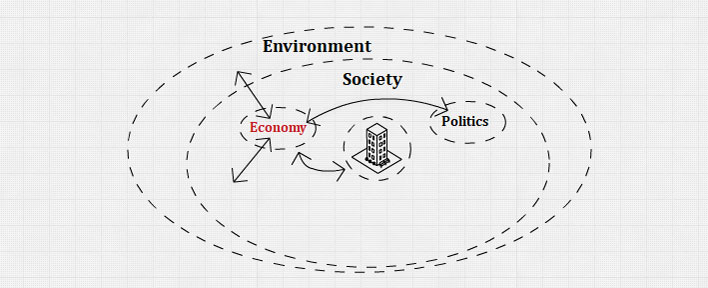
Economic force refers to the nature and direction of the economy in which a firm competes or may compete.
It consists of macro-level patterns related to the areas of production and distribution of wealth, income, expenditures, and resources that have an impact on the business of an organization.
Economic factors encompass such areas as the boom/bust cycle and the growth in unemployment in some parts of the country as a result of the closing of traditional industries.
The economic force also includes the general economic situation in the region and the nation, conditions in resource markets (money market, manpower market, raw material components, services, supply markets, and so on) which influence the supply of inputs to the enterprise, their costs, quality, availability, and reliability of supplies.
Economic force affects the general health and well-being of a nation or the regional economy of an organization, which in turn affects companies’ and industries’ ability to earn an adequate rate of return.
Economic factors decide the nature and direction of the economy in which a firm operates. Strategic decisions are influenced by economic factors; therefore, firms must monitor the economic environment continuously.
Business depends on the economic environment for all the required inputs and also to sell the finished goods. The dependence of business on the economic environment is not surprising because business is one unit of the total economy.
These concepts present both opportunities as well as threats for the business firms. The survival and success of each and every business enterprise fully depend on its economic environment. Ideally, firms want to pursue growth opportunities in regions and nations where they exist while avoiding the threats of slow growth periods in other settings.
It is challenging for firms studying the economic force to predict economic trends and events that may occur and their effects on them. Firms must regularly scan, monitor, forecast, and assess the health of their host nation as well as the health of the economies outside it.
These economic forces include elements such as interest rates, inflation rates, gross domestic product, unemployment rates, levels of disposable income, and the general growth or decline of the economy.
The 4 most important factors in the economic force are (1) economic conditions, (2) economic system, (3) economic policy, (4) economic growth, (5) interest rate, and (6) exchange rate.
Factor 1: Economic Conditions
Economic conditions refer to a set of economic factors that have a great influence on business organizations and their operations. They are the determinants of economic prosperity and the well-being of the community.
These economic factors help in improving the pace of economic growth. National income, per-capita income, economic resources, distribution of income and wealth, economic development are the variables that make economic prosperity. These include gross domestic product, per capita income, markets for goods and services, availability of capital, foreign exchange reserve, growth of foreign trade, the strength of the capital market, etc.
The income and its distribution determine the business prospects and, hence business strategies. In an economy where it is low and the per-capita is comparatively low, results in poor demand. This pessimistic situation does not attract business people to invest and carry on the manufacturing and marketing activities.
On the other hand, in case of those economies where the income of the economy is rising and that leads to more and more investments and entering into industrial and marketing activities.
Factor 2: Economic System
The economic system is an arrangement that encourages the generation of income, its distribution by use of resources at its disposal based on some accepted economic philosophy.
The economies all over the world are broadly wedded to cabalistic, socialistic, and communistic as pure breeds or hybrid economies called mixed economies. The types of the economic system, that are, socialist, capitalist, or mixed economy provide an institutional framework within which business firms have to work.
Capitalism: A capitalist economy is an economy where the laws of demand and supply operate freely. The capitalist system is one that is characterized by private ownership of the means of production, individual decision-making, and the use of market mechanisms to carry out the decision of individual participants and facilitate the flow of goods and services in the market.
Capitalism grants the maximum economic freedom in managing economic activities and socialism speaks of utmost control by the state and mixed economy has the freedom as well as the state’s role where both public and private sectors co-exist supporting one another.
Socialism: Socialism is an economic system where the means of production are either owned or controlled by the state and where the resources allocation, investment pattern, consumption, income distribution, etc., are directed and regulated by the state.
Mixed Economy: Mixed economy is the outcome of a compromise between two diametrically opposing schools of thought. In a mixed economy, private, public, and joint sectors and the like all have some say in the major decisions that influence the functioning of the economy.
Factor 3: Economic Policy
An economic policy is a set of decisions that are formulated and implemented by the government. All business activities and operations are directly influenced by the economic policies framed by the government from time to time.
Some of the important economic policies are (1) industrial policy; (2) fiscal policy; (3) monetary policy; (4) foreign investment policy; and (5) export-import policy.
Factor 4: Economic Growth
Economic growth is the rise and sustaining per capita income of every individual who is a member of the economy. It is the economic growth rate that speaks of increased consumption expenditure, lowering of pressure in the industrial field that offers more opportunities and makes the firms withstand the rigors of threats.
Economic growth leads to an expansion in customer expenditures, tends to produce a general easing of competitive pressures within an industry. This gives companies the opportunity to expand their operations and earn higher profits.
Economic decline (a recession) leads to a reduction in customer expenditures, it increases competitive pressures. It reduces consumption expenditure builds up the pressure and lowers down the profitability.
Economic decline frequently causes price wars in mature industries. In general, firms seek to compete in relatively stable economies with strong growth potential.
Factor 5: Interest Rates
Interest rates influence the demand for goods and services in the economy when the goods and services are bought through borrowed funds. In case the rate of interest is low, the demand for products may be consumer durables or non-durables. This gives fillip to the industries to grow.
The level of interest rates can determine the demand for a company’s products. Interest rates are important whenever customers routinely borrow money to finance their purchase of these products. Interest rates also have an impact on the sale of autos, appliances, and capital equipment, to give just a few examples. For companies in such industries, rising interest rates are a threat and falling rates an opportunity.
The cost of capital is also dependent on interest rates. The companies, when they are getting capital at the lowest rates will be a boosting dose for all companies to have ambitious plans and strategies in case of borrowed funds.
Factor 6: Exchange Rates
Exchange rates stand for the currency conversion into any other currency, which may be hard or soft.
Currency exchange rates define the value of different national currencies against each other. Movement in currency exchange rates has a direct impact on the competitiveness of a company’s products in the global marketplace. A low or declining dollar reduces the threat from foreign competitors while creating opportunities for increased sales overseas.
Factor 7: Price Inflation
Price inflation can destabilize the economy, producing slower economic growth, higher interest rates, and volatile currency movements.
If inflation keeps increasing, investment planning becomes hazardous. The key characteristic of inflation is that it makes the future less predictable. In an inflationary environment, it may be impossible to predict with any accuracy the real value of returns that can be earned from a project 5 years hence. Such uncertainty makes companies less willing to invest. Their holding back in turn depresses economic activity and ultimately pushes the economy into a slump.
Thus, high inflation is a threat to companies.
Force 5: Technological Force
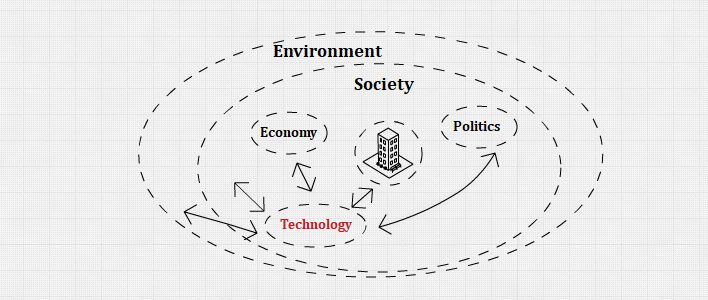
The technological force is about knowledge applied and the materials and machines used in the production of goods and services that have an impact on the business of an organization.
This force includes the institutions and activities involved in creating knowledge and translating that knowledge into new outputs. Pervasive and diversified in scope, technological changes affect many parts of societies. These effects occur primarily through ideas, products, processes, methodologies, and materials.
For many enterprises, technology is the most dynamic of all environmental factors. Among all the forces of the external environment, technological force exerts considerable influence on business. The impact of technological developments on business strategy is not only fast but also far-reaching.
Scientific research for technological improvement and innovation in products and services is a regular activity in most of the big industrial organizations.
Technological change can make established products obsolete overnight and simultaneously create a host of new product possibilities.
Rapid developments in technology exert a powerful influence on all organizations and not just on those operating in a high-tech environment. The combined impact of computer, digital technology, and telecommunications affects most of private and public sector undertakings.
The strategic implications of changing technology are as follows: (1) it can change relative competitive cost positions within a business; (2) it can create new markets and new business segments, (3) it can collapse or merge previously independent business by reducing or eliminating their segment barriers, (4) it can change the rate of new product development, (5) it can increase automation and advancement in product and service industries.
Technology force has the potential for changing the competitive structure of many industries.
It often lowers barriers to entry and reduces customer switching costs, changes that tend to increase the intensity of rivalry in industry and lower both prices and profits. The resulting increase in rivalry has given advertisers more choices, enabling them to bargain down the prices that they must pay.
In order to survive and grow in the market, a firm has to adopt technological changes from time to time.
Given the rapid pace of technological change and risk of disruption, it is vital for firms to thoroughly study the technological force. The importance of these efforts is suggested by finding that early adopters of new technology often achieve higher market shares and earn higher returns.
Thus, both large and small firms should continuously scan the macro-environment to identify potential substitutes for technologies that are in current use, as well as to identify newly emerging technologies from which their firm could derive a competitive advantage.
The improvement in technology can also raise the total factor productivity of a firm and reduces the unit cost of output. Thus, the development of technology can reduce or increase opportunities for a firm.
It can reduce opportunities when a firm is not able to see the technological changes taking place in the industry. Creative technological adoptions can suggest new opportunities for new products, or improvements in existing products, improving service quality, reducing manufacturing cost, and deliver products to end-users. Technological developments can have a sudden and dramatic effect on an organization’s internal environment.
Thus, firms particularly those in turbulent growth industries must strive to understand both the existing and probable future technological advances that can affect their products and services. Firms need to monitor the technological advancements taking place around and formulate strategies to suit the changes.
The use of superior technology by a firm gives it a competitive advantage over its rival firms.
The use of a particular technology by a firm for its transformation process determines its competitive strength. Therefore, technological development plays a vital role in enhancing the competitive strength of business firms.
Competition between firms in the domestic economy and in international markets ensures that the firms will try to improve the technology they use because failure to do so would pose a threat to their survival. In the protected markets, technological improvements are slow and firms are able to survive for a long period without making technological changes.
There are 9 major factors of technology force.
They are as follows: (1) Sources of technology like company sources, external sources, and foreign sources; (2) technological development, stages of development change and rate of change of technology and research and development; (3) impact of technology on human beings, the man-machine system and the environmental effects of technology; (4) communication and infrastructural technology and technology in management; (5) technological obsolescence; (6) pull of technological change; (7) opportunities arising out of technological innovation; (8) risk and uncertainty of technological development; and (9) role of research and development in a country and government’s research and development budget.
Force 6: Legal Force
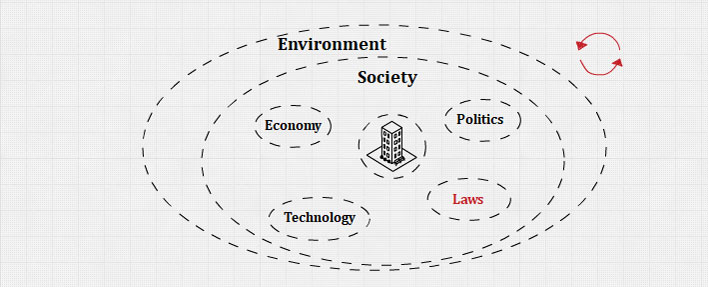
The legal force centers on how the courts influence business activity.
The legal force consists of factors related to the regulation of economic activities by the government that has an impact on the business of an organization.
Legal force represents outcomes of changes in laws and regulations. They result from legal developments within society and significantly affect companies. Society’s laws constraint the operations of organizations and thus create trends and events that signify both opportunities and threats.
Governments of the nation, states, and local area play a constructive role as the custodian of citizens. To protect and promote the interests of citizens, they resort to legal activities which can be done through constitutional provisions and industrial laws.
Businesses are closely related to the government. Regulations formed in response to new national, regional, state, and/or local laws that are legislated often influence a firm’s competitive actions and responses.
The legal environment includes various legislations passed by the government administrative orders issued by government authorities, court judgments as well as the decisions rendered by various commissions and agencies at every level of the government – federal, or state.
Examples of important legal factors include employment laws, health and safety regulations, discrimination laws, and antitrust laws.
Some of the important areas of control are: (1) industrial policy and licensing; (2) monopolies and restrictive trade practices; (3) legislation related to a company’s operation; (4) import and export control and control over foreign exchange; (5) control over foreign investment and collaboration; (6) control through consumer protection; and (7) control of environmental pollution.
Legal factors follow on from political factors, as the governments often pass laws that affect business.
In most countries, the interplay between political and legal forces, on the one hand, and industry competitive structure, on the other, is a two-way process in which the government sets regulations that influence the competitive structure, and firms in an industry often seek to influence the regulations that governments enact by a number of means.
Firms may provide financial support to politicians or political parties that espouse views favorable to the industry and lobby government legislators directly to shape government regulations.
Resources
Further Reading
- Macro Environment Analysis (whatmakesagoodleader.com)
- What Is Macro Environment? (pestleanalysis.com)
- What is Macro Environment? Definition and Examples (marketingtutor.net)
- Strategic Analysis & Planning Series: Macro External Analysis (equimanagement.com)
Related Concepts
References
- Hitt, M. A., Ireland, D. R., & Hoskisson, R. E. (2019). Strategic Management: Concepts and Cases: Competitiveness and Globalization (MindTap Course List) (13th ed.). Cengage Learning.
- Mastering Strategic Management. (2016, January 18). Open Textbooks for Hong Kong.
- Wheelen, T. L. (2021). Strategic Management and Business Policy: Toward Global Sustainability 13th (thirteenth) edition Text Only. Prentice Hall.